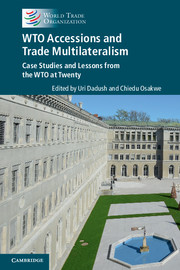Book contents
- Frontmatter
- Dedication
- Contents
- List of contributors
- Foreword
- Acknowledgements
- List of abbreviations
- Editors' note
- PART I WTO accessions, the trading system and the global economy
- PART II Overview: systemic outcomes from accessions
- 9 Contributions and lessons from WTO accessions: the present and future of the rules-based multilateral trading system
- 10 WTO rule-making: WTO Accession Protocols and jurisprudence
- 11 The evolution of the GATT/WTO Accession Protocol: legal tightening and domestic ratification
- PART III Members’ perspectives on accession negotiations
- PART IV Working party chairpersons’ perspectives on accession negotiations
- PART V Salient features inWTOAccession Protocols
- PART VI Conclusion
- Annex: Contributor biographies
- Index
- Plate section
10 - WTO rule-making: WTO Accession Protocols and jurisprudence
from PART II - Overview: systemic outcomes from accessions
Published online by Cambridge University Press: 05 November 2015
- Frontmatter
- Dedication
- Contents
- List of contributors
- Foreword
- Acknowledgements
- List of abbreviations
- Editors' note
- PART I WTO accessions, the trading system and the global economy
- PART II Overview: systemic outcomes from accessions
- 9 Contributions and lessons from WTO accessions: the present and future of the rules-based multilateral trading system
- 10 WTO rule-making: WTO Accession Protocols and jurisprudence
- 11 The evolution of the GATT/WTO Accession Protocol: legal tightening and domestic ratification
- PART III Members’ perspectives on accession negotiations
- PART IV Working party chairpersons’ perspectives on accession negotiations
- PART V Salient features inWTOAccession Protocols
- PART VI Conclusion
- Annex: Contributor biographies
- Index
- Plate section
Summary
ABSTRACT
This chapter examines rule-making in the WTO. It explains the legal provisions governing how rules are made in the WTO, and describes WTO rule-making in practice, including through the adoption of decisions by the Ministerial Conference and the General Council and by way of dispute settlement. The role of consensus and voting in WTO rule-making are discussed. The chapter also refers to different types of rules and decisions – such as ministerial declarations, authoritative interpretations, amendments and waivers – and considers their legal value and effect, as well as how different types of rules or decisions have been interpreted or applied. Finally, it also includes a look at rule-making in the context of accessions, and considers Accession Protocols and working party reports through the lens of WTO dispute settlement.
This chapter does not purport to be a comprehensive review of decision-making in the WTO. Rather, it offers a general overview that may be useful to those involved in rule- or decision-making, be they delegates, chairpersons, secretaries to committees or other followers of the WTO. It may assist them in choosing the appropriate avenue to follow in making a rule or decision, depending upon the effect the instrument is intended to have in the WTO. It may also serve to provide guidance to those involved in crafting rules or decisions or other instruments, especially in its explanation of the importance of careful and precise legal drafting. Finally, it may alert those preparing for dispute settlement in which a particular instrument – such as a ministerial decision or an accession protocol or a working party report – may have been invoked to the lessons that may be drawn from the jurisprudence addressing the import of such instruments.
Rule-making lies at the heart of the WTO, as it did in the days of its predecessor, the General Agreement on Tariffs and Trade (GATT). The practices and procedures in rule-making have evolved somewhat since GATT's inception in 1947, but the general approach remains the same today. At the creation of the GATT, the fundamental approach was that international trade relations should be governed by the rule of law. This approach informed the functioning of the GATT throughout its forty-seven years, directed its transition to the WTO in 1995 and guides the WTO today.
- Type
- Chapter
- Information
- WTO Accessions and Trade MultilateralismCase Studies and Lessons from the WTO at Twenty, pp. 309 - 347Publisher: Cambridge University PressPrint publication year: 2015



